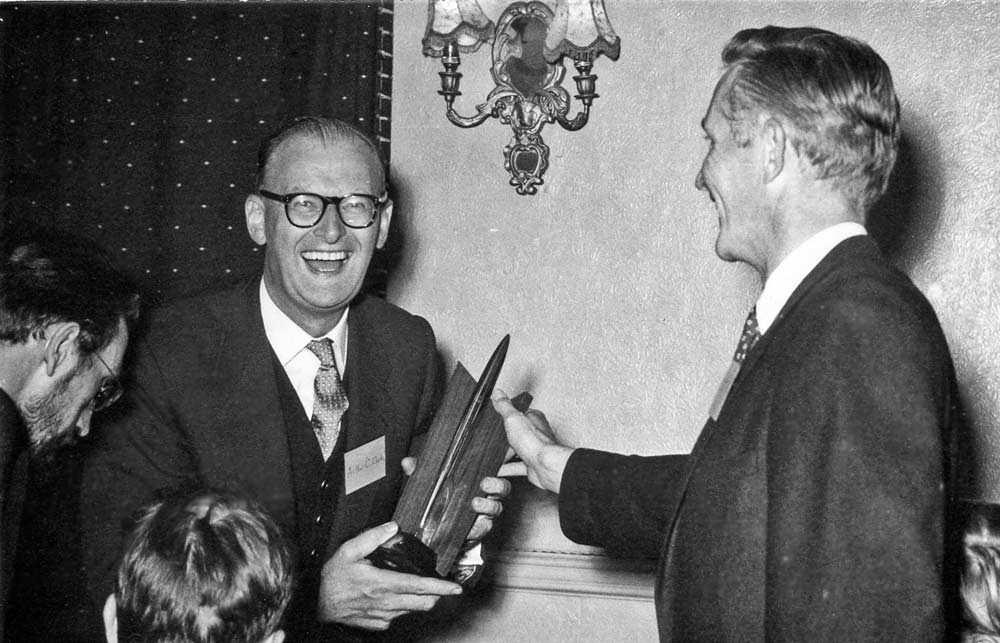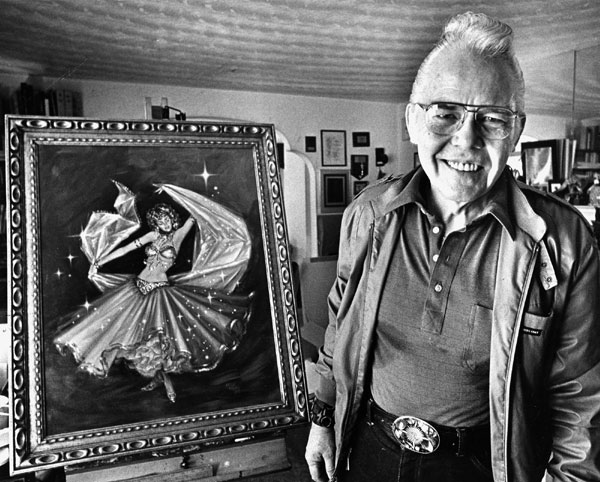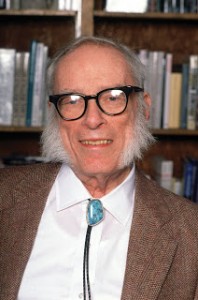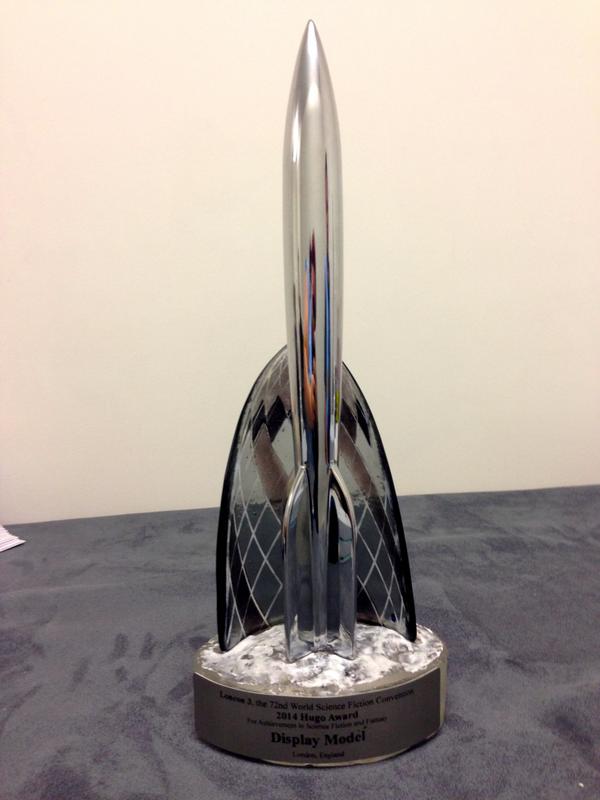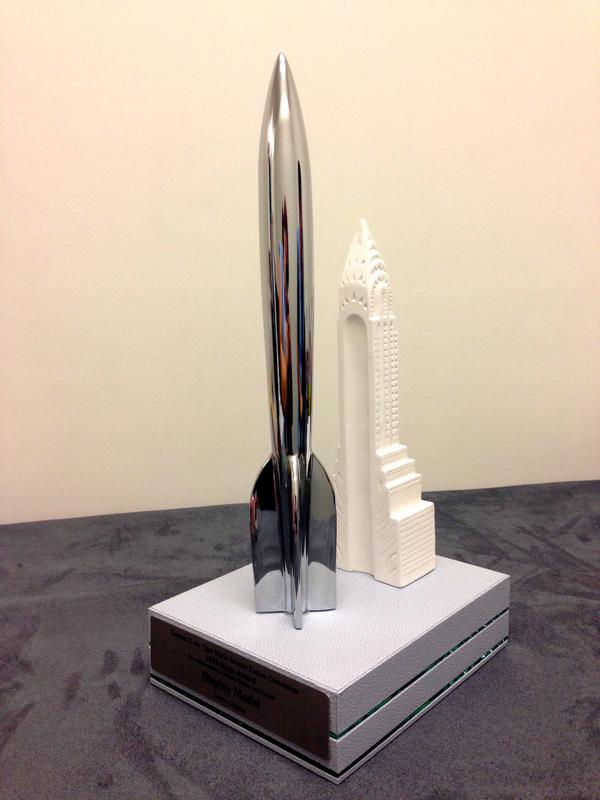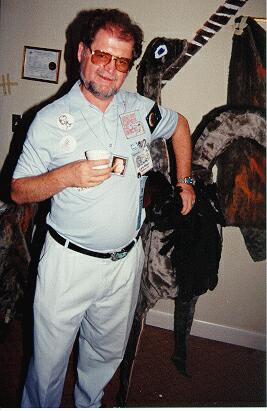
Larry Niven with a Puppeteer at Louis Wu’s Birthday Party. Photo by Gordon McGregor from Fanac.org.
Twenty-five years ago today Noreascon Three began in Boston, Massachusetts. I’ve been working on a post about its epic Science Fiction’s 50th Anniversary Family Reunion Sunday brunch which will appear September 3. The research has reminded me it was a superb once-in-a-generation convention and I have decided to republish my whole conreport in daily installments.
SF Tonight! Pam Fremon, Ellen Franklin and Tappan King created a format where Andre Norton and the other guests were seconded by their closest friends in sf and presented to a large audience in a warm and personal way. In that atmosphere the intended homage was paid to each guest and these charming but delicate individuals were not tossed into a den of 2,000 couch potatoes demanding to be entertained.

Tappan King in 1992.
There was a minute-by-minute timeline for the show – this was Noreascon after all – but with 36 hours to go the script wasn’t done. Tappan King, host and headwriter, confessed, “I’ve been working at Tor the last two weeks and invisible weasels have been eating the gray matter.”
My job was to play Ed McMahon to Tappan’s Johnny Carson; I loved my role in Tappan’s outline and existing script, but welcomed even more an opportunity to brainstorm and help improvise the rest of the business.
The major brainstorming session was Thursday night at 10 p.m. I had fed my brain at Legal Seafood: squid, scrod and a brew. Trotting six blocks back to the Hynes I was a little late. Already at work, and on the verge of finishing “10 Reasons To Leave Fandom” were Tappan, Heather Wood (also of Tor, our kazoo-playing answer to Doc Severinsen), Priscilla Olson, Tom Whitmore, Ellen Franklin, Deb Geisler and some others (wish I’d made a list.) Thinking up the between-guests business and the pseudo-announcements was a lot of fun. The only thing we were barred by management from doing was jokes about ballot stuffing.1
Friday afternoon was the technical rehearsal for SF Tonight! (Somehow that phrase entangles in my mind with “…technical readout of the DeathStar…”) The tech crew efficiently set the microphone levels and coordinated the stage lighting with the Hynes electricians. Tom Whitmore and Tamzen Cannoy led the talent in setting the stage, placing furniture and checking sightlines.
Ellen Franklin, part of Hasbro’s management, had borrowed some toy fair backdrop scenery, swatches of Martian desert painted on sheets of canvas, to hang at the back of the stage.
At 8:30 p.m. 2,000 people were in the auditorium. I got my cue and stepped into the spotlight: “And now – live! – from the John B. Hynes (after whom the sloop was named) Convention Center in downtown Boston, Massachusetts, it’s SF Tonight! — brought to you by First Fandom, purveyors of used parts, the Permanent Floating Worldcon Committee and SFWA Chewable Vitamins. Now here is your host – TAPPAN KING!”
Tappan led into our Letterman-inspired “10 Reasons Not To Leave SF,” then talked to the guests.
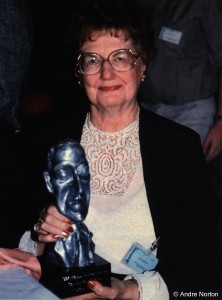
Andre Norton at World Fantasy Con in 1987.
Andre Norton was preceded by two friends, Susan Shwartz, and Tom Doherty of Tor Books. Doherty told Tappan that one of his first acts as head of Tor was to fly down to visit Andre Norton because he’d heard she was dissatisfied with her publisher and he regarded her books as very important to the company. An extra benefit of having Doherty present was the assurance of a strong arm to escort Andre Norton to the sofa (given that she moved around the convention mainly by wheelchair). Tappan and Andre Norton had a good exchange, and the audience reacted enthusiastically to Norton.

Ian Ballantine

Betty Ballatine
Fred Pohl started the second set telling about the Ballantines. Richard Powers, well-remembered as a Ballantine Books cover artist, joined Pohl and answered questions about his career. Then Betty and Ian Ballantine were ushered in. Before that Tappan King told us, “These people are my ghods!” Although visibly moved, Tappan got through the questions without a hitch.
Between guests I stepped over to the podium and read some our concocted announcements chronically interrupted by the “Marseilles” howled on kazoos.
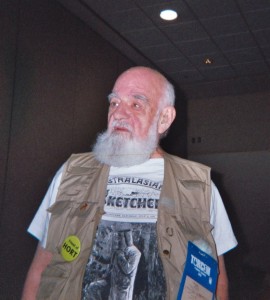
Art Widner at Torcon III in 2003.
In a third segment Art Widner and Hal Clement of the Strangers Club2 related that Widner got the club’s name from a series of sf stories he’s never actually read. The club’s legacy included Louis Russell Chauvenet’s invention of the term “fanzine.” Among the Strangers’ most memorable meetings was one attended by John W. Campbell and L. Ron Hubbard, and Art told what it was like to be around those two lions of sf in their prime.
I had so much fun I couldn’t possibly be objective and went looking for people to ask about the show. All my friends, being too cool to go to programming, had gone off to baseball games and seafood restaurants so I’m still looking, but Chairman Mark Olson noted later, “I saw half of SF Tonight! when it happened and most of the rest of it looking at the mixdown video tape. I enjoyed it and have heard that we’re getting good reviews on it. (Certainly Andre Norton was delighted with her part in it.”)
A Nation of Ribbon Clerks: After SF Tonight! I wandered up to Program Oops to check on the night shift, who looked remarkably like the day shift, Priscilla Olson, Ben Yalow, and Fred Duarte.
A bonus was getting my Hugo nominee pin. Noreascon gave each nominee a 1-1/2 inch replica of the Hugo rocket. I attached mine to my membership badge which by then was looking satisfyingly like the fruit salad on the uniform blouse of a commandante of the Bolivian Coast Guard.
The Noreascon Three membership badge was a great big laminated square with your name and town in LARGE laser-printed letters under a blue line-drawing of a Cheshire cat in a spacesuit. The cat grinned through its fishbowl-shaped helmet and held a party horn in one paw (which didn’t seem like good science and I was sure Hal Clement would criticize…)
Attached to my badge with duct tape was a “gizmo” identifying me as part of the Program Division. Staff wore them to be readily accessible to members. Some gizmos were special. Seth Breidbart had a flock of them hanging down from his badge, including “Hoax Division” and “This Space Intentionally Left Blank.” Sue Hammond’s gizmo said “Ice Princess” – Sue was in charge of giving away the tons of party ice on the Sheraton loading dock.
I had five ribbons pinned to my gizmo, out of many printed for Noreascon Three participants. I had a green Committee ribbon, a maroon Program Participant ribbon, an orange Hugo Award Nominee ribbon, a black Exhibitor ribbon, and one of Seth’s yellow Hoax ribbons. I’d have made it into the Guinness Book of Records if I’d found the time to claim my sixth ribbon, the half-white half-red one given to the Press.
After I got my Hugo pin, Tony Lewis wanted to show off Boston’s Hugo Award base. He convoyed me to another inner sanctum of the Hynes where Jill Eastlake allowed me to gaze from a discreet distance at the beautiful art deco bases. Taking inspiration from the 1939 World’s Fair Trylon and Perisphere, the circular black base was stepped with a smaller-radius granite base. The chrome rocket appeared to have landed on the granite, bull-eyeing a circular green ellipsis inset with small chrome and glass orbs, and sprinkled with tiny brass knobs and doohickeys.
 Louis Wu’s Birthday Party: Leaving Tony, a plan to drop off my coat and tie in my ninth floor room failed to survive contact with the mobs at the elevator bank. But I hadn’t wandered more than 10 feet when a new plan took shape: Scott Welch in a fivesome from Bridge Publications was on his way to the biggest bash of the night, Louis Wu’s Birthday Party, and invited me to come along. Boxboro Fandom’s3 farewell blowout cost a rumored $17,000.
Louis Wu’s Birthday Party: Leaving Tony, a plan to drop off my coat and tie in my ninth floor room failed to survive contact with the mobs at the elevator bank. But I hadn’t wandered more than 10 feet when a new plan took shape: Scott Welch in a fivesome from Bridge Publications was on his way to the biggest bash of the night, Louis Wu’s Birthday Party, and invited me to come along. Boxboro Fandom’s3 farewell blowout cost a rumored $17,000.
The Boxboro party was in the Back Bay Hilton and everyone knew there was a line around the corner waiting to get in because the hotel would admit only about 545 individuals at once (blaming it on that bogeyman the fire marshal.) However, the “Scott Welch party” had passports and blue tickets certifying them as “Special Guests of Louis Wu” that allowed us to jump the line – we replaced the next five people out the door. Scott’s party would have graced any occasion for it included Edgar Winter, a performer so renowned that jaded fans scrambled from all corners of the party when he took the stage in the Mardi Gras room.
Inspired by the birthday bash in Niven’s Ringworld, Boxboro encouraged fans as they walked around the party to imagine they were being transported to these (sometimes improbable) locations.
From the top of the stairs partiers were attracted by the hot jazz trombones and cornets blaring in the Mardi Gras Room as the band set a frenetic beat for a score of dancers, including Julie Schwartz and his well-endowed date. (“They always are,” said Craig Miller.) Joey Grillot, everyone’s favorite New Orleans fan, sang along with “Mack the Knife.” Though he never hit a single note Joey scored points for enthusiasm.

Good and Evil at the Boxboro party. Photo by Gordon McGregor from Fanac.org.
The Mardi Gras room was reached by way of the Puppeteer World, notable for the cardboard circles on the floor simulating stepping-disk sidewalks. The warm pastel yellows of the puppeteer room were in stark contrast to the roulette red-and-black of the Mardi Gras room. With Edgar Winter in tow the Scott Welch party made a beeline for the sound of Bourbon Street.
Eyes adapted to dim nightclub-style lighting could read the signs on the wall naming the party’s sponsors, announcing that the band was the Hi-Tops, and noting this particular night spot was “The Silent Club.” A picture of a large bludgeon with golden spikes driven through the meat end was captioned, “You never hear a silent club coming…until it’s too late!”

Edgar Winter
When he introduced Edgar Winter, Scott flashed the “Mission Earth” album cover. Winter performed Hubbard’s score on the record. At the party Edgar Winter laid them in the aisles with two incredible blues numbers. Winter even played the sax. Photographers sprawled at his feet on the dance floor. Fans jammed the perimeter either listening raptly, or like Ellen Franklin, rocking and clapping in time.
Robert Neagle of New Orleans looked right at home in The Silent Club wearing a white shirt captioned “Porno Patrol” in scarlet letters. Neagle was plainly awestruck by Winter.
After Winter finished his set I prowled the party looking where its rumored $17,000 had gone, which obviously wasn’t for the snacks in the Mardi Gras room: they looked pretty funky. There were bowls full of oblong pretzel droppings and at the rate fans were consuming them each bowl would be a lifetime supply. Normally locust-like fans were able to resist several kinds of generic chips. A lot of this stuff probably sounded tasty when the hosts were compelled to order it from Hilton catering, but snacks delivered in 5-gallon cardboard boxes inevitably have a certain industrial toughness.
Next door, the Nippon Room featured a hi-tech Japanese theme. Rock music provided by “Crime of Fashion” accompanied a laser show playing on the ceiling. A sushi bar occupied the far wall. To the right was a simulated video wall with four big-screen monitors playing a Japanese rock video while people danced to the music. My path was momentarily blocked by a Japanese fan taking his friends’ photo, which seemed completely appropriate and may even have been genuine.
Attached to the wall behind the sushi bar was some ominous plumbing variously labeled “Omni Trap,” “Detoxification Filter,” “Blasting Agent,” “Corrosive Liquid,” “Cyclohexanone,” and “Specialized Activated Carbon” which may have been a recipe for Kzin deodorant or the plot for Greg Bear’s next novel. Hopefully it wasn’t the ingredients for the Mad Tea Party next door.
There were 40 fans lined up at the Mad Tea Party behind ropes and stanchions, and I couldn’t believe it was merely for tea and cake. Nor was it. They were waiting their turn to take a wooden pink flamingo mallet in hand and play through the croquet course laid out in the next room.

Ron Gerard with Puppeteer. Photo by Terry McGarry.

Graham Collins as the Cheshire Cat. Photo by Terry McGarry.

Graham Collins playing flamingo croquet. Photo by Terry McGarry.
Thanks to transporter booths the Kzin embassy and the Ringworld map room were just around the corner from Wonderland. Color monitors showed computer graphics vaguely suggestive of celestial navigation. A slide carousel projected quotes from Ringworld. There were life-size Kzin and puppeteer mannequins (alienquins?) Costumer Drew Sanders stalked around the party in a furry and incredibly hot Kzin outfit [originally an entry in the 1984 Worldcon masquerade].
These last rooms boasted a more aggressive range of munchies including fruit and vegetables, and some remarkably courageous chefs carving huge joints of meat in the Kzin embassy. (Where else?)
Francis Hamit said Louis Wu’s birthday party reminded him of Universal Studios – five attractions and a lot of standing in line. But I say it was a hell of a party.
Notes
1. “The only thing we were barred by management from doing was jokes about ballot stuffing.” There had been a controversy about the votes cast for one nominee, which was resolved by the nomination being declined.
2. The Strangers Club. The Boston science fiction club co-founded by Russ Chauvenet in 1940. He coined the word fanzine the same year. When did he sleep?
3. Boxboro Fandom. One of the greatest convention party-throwing crews. Steve Boheim’s reminiscence here has the details. Larry Niven also wrote about the aftermath in N-Space:
Boxboro’s Hotel Liaison was a straight-looking guy who never raised his voice or appeared without a tie: a proper gent. And heck, they were taking the whole second floor! So the Hilton Manager was cooperative. She signed the thick contract without really noticing a clause near the end.
Getting the prop walls for the Kzinti Embassy into the hotel was tough. They’d measured the largest doors – the front lobby doors! – but hadn’t measured them open. Open, they were too small. Boxboro considered taking them off their hinges, with and without permission. They considered junking the props. They were sure the prop walls wouldn’t come apart, but someone tried it, and they did.
Still, the only feasible way to get them out after the party would be to hack them apart with a chainsaw! That would allow the debris to fit into a dumpster. So they put it in the contract.
“I can’t believe they let you use a chainsaw at four in the morning!” the Hotel Manager wailed. But she didn’t stop them. It was in the contract.
4. Final note. The convention’s name was officially agnostic: “Noreascon 3”, “Noreascon Three” and “Noreascon III” were all declared correct forms of the name.



